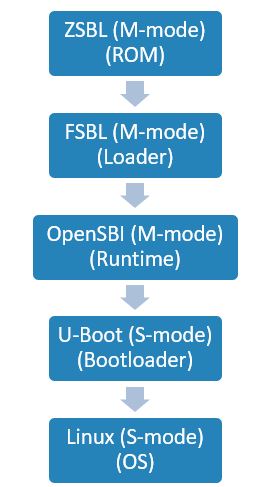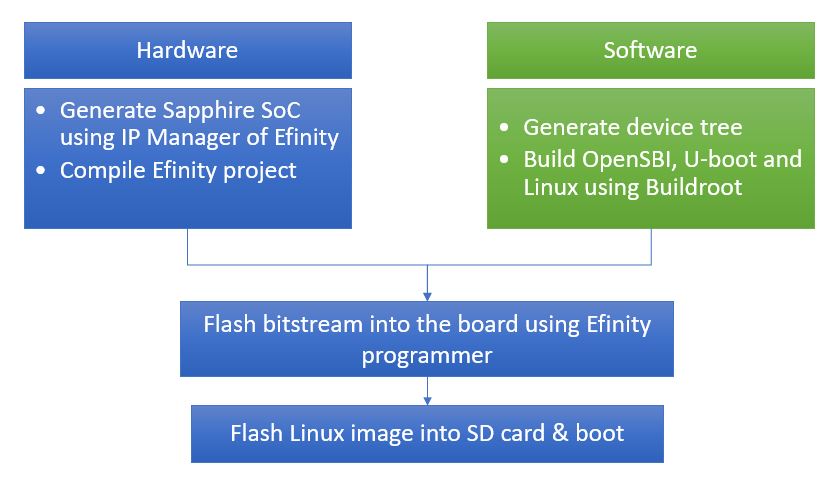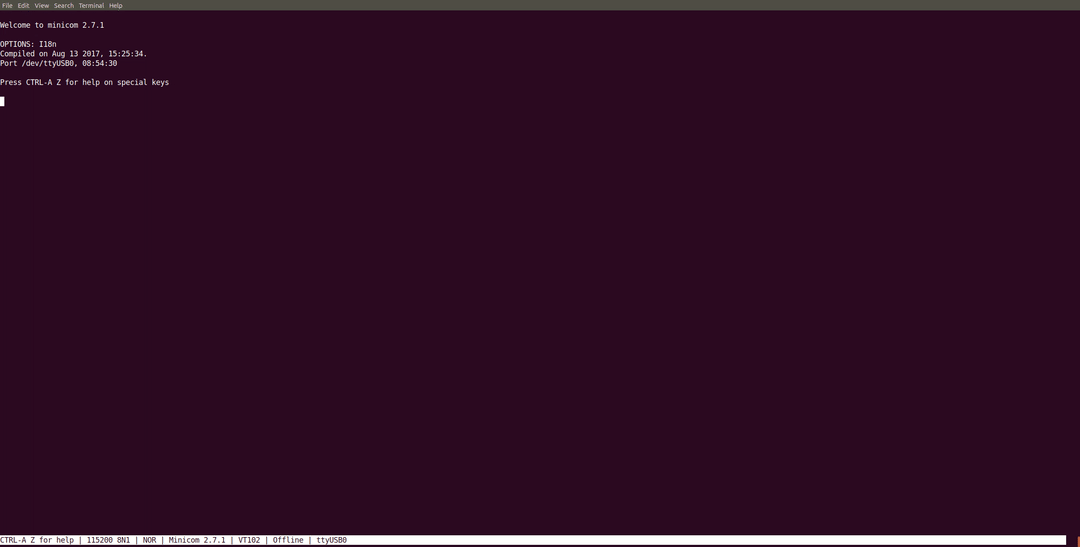Welcome to BR2-Efinix.
BR2-Efinix is a custom Buildroot external tree for building Linux for Efinix Sapphire RISC-V SoC. Customized configurations to support Sapphire SoC is given, where OpenSBI, U-boot, Linux, Buildroot configuration files as well as patches are provided.
Buildroot is a simple, efficient and easy-to-use tool to generate embedded Linux systems through cross-compilation. Learn more at Buildroot official website.
OpenSBI project provide an open-source reference implementation of the RISC-V SBI specifications for platform-specific firmwares executing in M-mode. Learn more at OpenSBI repository.
U-Boot is a boot loader for Embedded boards based on RISCV, PowerPC, ARM, MIPS and several other processors, which can be installed in a boot ROM and used to initialize and test the hardware or to download and run application code. Learn more at U-Boot repository.
image from https://riscv.org/wp-content/uploads/2019/12/Summit_bootflow.pdf
When the board power on, the first stage bootloader copy OpenSBI and U-Boot from SPI flash to external memory (RAM). Then, OpenSBI get executed to initialize the memory, stack pointer, cpus and jump to U-Boot. U-Boot load the Linux kernel and start the Linux.
The Sapphire SoC is based on the VexRiscv core created by Charles Papon. The VexRiscv core is a 32-bit CPU using the ISA RISCV32I with M, A, F, D, and C extensions, has six pipeline stages (fetch, injector, decode, execute, memory, and writeback), and a configurable feature set. See RISC-V Sapphire User Guide from Efinix Support page for more detail on Sapphire SoC.
Some libraries and tools are needed to be installed for building Linux.
Tested on Ubuntu 18.04 LTS
sudo apt-get update && sudo apt-get upgrade -y
sudo apt-get install -y sed make binutils build-essential bash patch gzip \
bzip2 perl tar cpio unzip rsync file bc wget autoconf automake libtool \
mtools jq minicom
This repo require specific version of Buildroot to work with. See the VERSION file for the compatible Buildroot version.
- 2.2 and above
- Efinity 2022.2 and above
- Follow the official documentation on installation process.
-
v2022.2.322 and above
-
Follow the official documentation on installation process
-
Learn more at the official website
- Supported Efinix devkit
- 1GB micro SD card
- PMOD microSD card module*
- UART module*
- 3x male-to-female jumper cable*
- 1x MIPI and LVDS extension daughter card*
- 2x USB micro cable*
- External SD Card reader (if integrated SD Card Reader unavailable)
- MicroSD Adapter to adapt MicroSD to SD Card Reader (if MicroSD Card Reader unavailable)
Note: * only required for Trion T120F324.
For hardware setup please refer to setup development board document.
The development flow divided into hardware and software. The hardware part more to generating the SoC FPGA bitstream while software more to build Linux kernel and related user space packages.
Efinity software is required to generate the Sapphire RISC-V SoC. There are two ways to generate the Efinix Sapphire RISC-V SoC.
Preconfigure Efinity project with Linux also provided in the repository for quick start. User just need to unzip the project and load the soc.xml project file in the Efinity software and click Synthesize button to generate the fpga bitstream.
-
T120F324
-
boards/efinix/t120f324/hardware/1-core/soc1.zip -
boards/efinix/t120f324/hardware/4-cores/soc4.zip
-
-
Ti60F225
-
boards/efinix/ti60f225/hardware/1-core/soc1.zip -
boards/efinix/ti60f225/hardware/2-cores/soc2.zip
-
-
Ti180M484
-
boards/efinix/ti180m484/hardware/1-core/soc1.zip -
boards/efinix/ti180m484/hardware/4-cores/soc4.zip
-
The compiled bitstream file also provided for quick start in soc.zip format. This file stored in the Efinity project file for each supported development board. By using these files, user are not require to load and compile the Efinity project. User just need to unzip the file before use.
Follow the generate Efinix Sapphire RISC-V SoC document to generate the custom soc that can boot Linux.
Follow these steps to build Linux image, OpenSBI and U-boot for T120F324 development kit. These steps will build Linux based on Buildroot 2021.05.3
-
Clone this repository.
git clone https://github.com/Efinix-Inc/br2-efinix -b 2021.05.6 cd br2-efinix -
Run
init.shscript.init.shrequire 2 arguments. First argument is board name such ast120f324. Second argument is/path/to/soc.h. You can get thesoc.hfromEfinityproject directory. For example,$EFINITY_PROJECT/T120F324_devkit/embedded_sw/soc1/bsp/efinix/EfxSapphireSoc/include/soc.h.Please note that
$EFINITY_PROJECTis path to your Efinity project.source init.sh t120f324 $EFINITY_PROJECT/T120F324_devkit/embedded_sw/soc1/bsp/efinix/EfxSapphireSoc/include/soc.h
If you are using preconfigure Efinity project for T120F324 with 4 cores, then point the path to
soc.has followssource init.sh t120f324 boards/efinix/t120f324/hardware/4-cores/T120F324_devkit/embedded_sw/soc1/bsp/efinix/EfxSapphireSoc/include/soc.h -
Build the Linux.
make -j$(nproc) -
The output images are located in
<path/to/br2-efinix/../build_t120f324/build/images.-
sdcard.imgis a Linux image -
fw_jump.binis an OpenSBI image -
u-bootis an U-boot image
-
-
Flash firmware images.
- Follow Flash firmware image document for flashing the fpga bitstream, opensbi and u-boot into the T120F324 devkit.
-
Flash Linux image
sdcard.imgin to SD card.-
you can use Etcher for Linux
-
or, Linux command line to flash the Linux image into SD card. See flash linux document.
-
-
Access the board serial console over USB UART. See accessing uart terminal document.
-
Example of Linux boot.
-
Use the login prompt as
rootat linux prompt. -
Try run gpio demo application. See gpio for more info. Observe the LEDs blinking on the T120F324 board.
modprobe gpio gpio_app
You might want to write you own driver or custom application but do no know how to integrate it with Buildroot. See kernel module and package tutorial.
Currently supported board as follows
- Trion T120F324
- Titanium Ti60F225
- Titanium Ti180M484
This project is licensed under the GPLv2 or later.
Buildroot is licensed under the GPLv2 or later with exceptions.


